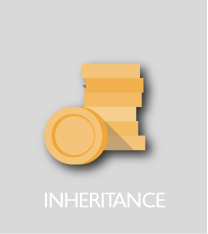Passing On Wealth
Inheritance Tax Planning
The amount we can pass on to our family or other beneficiaries (the Nil Rate Band), has not increased since 2009/10 and will remain at £325,000 until the end of 2020/21. A new relief is being introduced, the ‘Main Residence Nil-Rate Band’, which will be available for anyone who passes on their property to a direct descendant. This will be for an additional £100,000 from 2017/18, rising to £175,000 in 2020/21. This will only be available for properties worth £2,350,000 or less. There are many potential inheritance tax planning opportunities which clients could take advantage of to mitigate for this tax.
Use IHT exemptions
The starting point for anyone who is wishing to carry out inheritance tax (IHT) planning is to use their exemptions. There are a number of IHT exemptions available and where possible clients should consider making maximum use of these.
The most common ones being:
- Annual exemption – each individual can give away £3,000 each year, and use the previous year’s exemption if not already used.
- Small gifts exemption – up to £250 can be given to any number of individuals (note this exemption cannot be combined with any other exemption in favour of the same person)
- Normal expenditure out of income – gifts can be made out of surplus income provided the gift does not affect the donors’ usual standard of living.
Exemptions also apply to gifts on the occasion of a marriage and gifts to charities and community amateur sports clubs.
Planning in this area is often overlooked or ignored with few clients using such exemptions to the full potential. Over time regular use of these exemptions can result in significant IHT savings. Take the example of someone who has made use of their annual exemption over say 20 years – £60,000 would have been gifted free of IHT, saving £24,000 in tax!
Making larger gifts during your lifetime
In some cases it may be possible for you to make other lifetime gifts, whether outright to another individual or by executing a trust.
The current regime for outright gifts is favourable, thereby providing scope for lifetime planning. Gifts are normally ‘potentially exempt transfers’ (PETs) for IHT, meaning that no lifetime tax is payable on the gifted amount, or on any increase in value if the donor survives for the required seven-year period. Also, there is no limitation on such gifts or on the amounts which can be gifted. So provided the person making the gift is in reasonable health and is happy to make such gifts, substantial IHT savings can be made. The same IHT treatment also applies where the client wishes to execute a bare (absolute) trust, which in turn will also fall out of account provided the settlor survives seven years from the date the trust is created.
Outright gifts to another individual/bare trust, provides for the more simplistic type of planning, not only by taking advantage of the PET regime but also because very little administration requirements are needed.
In cases where an outright gift is not a suitable option because you wish to retain control or where a bare trust is concerned, do not wish their beneficiaries to receive the trust assets at 18, a flexible/discretionary trust could be used. The trust will allow for the ultimate destination of assets to be determined under its terms in accordance with your wishes. Today most forms of trusts where control of the assets is maintained are taxed on creation, when capital is appointed out of trust and on each tenth year anniversary. These are more commonly known as an entry, exit and periodic charge. And in some cases reporting obligations may also need to be fulfilled.
There are also a number of other types of trusts which are widely available for IHT planning purposes which can be used where access is available if required, for example a gift and loan trust, a loan trust and a discounted gift and income trust. Advice should be sought to determine which (if any) of these options are likely to be suitable.
Discretionary will trust planning
Since 9 October 2007 it has been possible for personal representatives to make a claim within two years of the second spouse’s/civil partner’s death to use any unused percentage of the first spouse’s/civil partner’s nil rate band. The unused percentage is based on the nil rate band applicable at the time of second death. This provides for the increase in the nil rate band over time. With the nil rate band being frozen until 2017/18, clients could consider whether discretionary will trust planning is a viable option, especially because assets would be expected to grow at a faster rate than the frozen nil rate band.
Example
Peter’s estate is valued at £325,000 and under the terms of his will his entire estate passes to his wife Sharon. Peter dies on 20 December 2013. Four years later, having been diagnosed with a critical illness, Sharon dies with an estate valued at more than £325,000 in addition to Peter’s gift. Assuming the assets grow at just over 6% per annum the inheritance from Peter is now worth £410,304. However, because Peter had left all of his assets to Sharon, the total amount together with her own assets would be included in her taxable estate for IHT purposes. On her subsequent death, even if her personal representatives were to make a claim to use Peter’s nil rate band, her estate together with the inherited amount is well in excess of the combined nil rate band of £650,000.
In addition, because the nil rate band remains frozen at £325,000, £85,304 of Sharon’s inheritance will now be taxable at 40% and incur an IHT charge of £34,121.
However, if Peter had created a discretionary will trust for his available nil rate band of £325,000 the position would be different as the whole amount of £410,304 would have fallen outside of Sharon’s taxable estate.
In addition, it is possible for the trust to be drawn with a wide beneficiary class and therefore Sharon could be included as a beneficiary of the trust. This means that she could still continue to benefit during her lifetime without compromising her own financial position.
Some of the benefits which can be obtained by will trust planning:
- Provides certainty that the planning is in place and will equally be safeguarded against third party claims that could arise on the surviving spouse’s estate, e.g. on bankruptcy or remarriage or to fund nursing home fees.
- Suitable for those who are on their second (or subsequent) marriage, by providing peace of mind as clients can be sure that trustees will be able to make appointments in favour of their chosen beneficiaries.
- The value of the trust fund does not vest in anyone’s estate for inheritance tax purposes, which means that beneficiaries can benefit from assets without increasing their own inheritance tax estate.
- Discretionary will trust planning also eliminates the need to make a ‘transferable nil rate band claim’ by the personal representatives, which reduces the administration aspects for them.
Deeds of variation
Where property is inherited, whether under a will, under the intestacy rules, or by survivorship, it is possible to redirect the inheritance to achieve an immediate IHT saving by using a deed of variation. To achieve the desired outcome, this planning must satisfy the relevant conditions (see below) and the property must have been included in the deceased’s estate at the date of death.
Ordinarily the inherited assets will accumulate with the taxable estate of the receiving beneficiary who may not want or need the inheritance. Instead of choosing to make a gift of the inheritance (which would either be treated as a potentially exempt transfer or a chargeable lifetime transfer), a client can take advantage of the deed of variation option to make an immediate inheritance tax saving on their own estate.
For a variation to be valid the following conditions must be satisfied:
- The variation must be in writing (usually by deed)
- It must be made within 2 years of the death
- It must be made by the person(s) who would have benefited from the original gift
- The document must contain a statement that the relevant legislation (s142 IHTA 1984) is intended to apply
There is no requirement to vary the entire amount of the inheritance enabling the client to choose to vary only part of it. It is possible to vary an amount directly to an individual or to a trust. The option chosen will of course depend on the client’s specific circumstances taking account of factors such as whether they are wealthy in their own right, whether they are likely to want to retain control and whether they may wish to benefit in future should the need arise.
A variation into a discretionary trust enables the client to retain access by being named as a beneficiary. This is a viable planning option which does not fall foul of the gift with reservation provisions or pre-owned assets tax – the variation is effectively treated as having been made by the deceased for IHT purposes provided the necessary conditions are satisfied. Note in cases where the variation is into trust and the client is included as a beneficiary, they will be taxable on any income arising within the trust under the settlor-interested trust provisions.
Example
Brian dies leaving an inheritance of £150,000 to his daughter Samantha. After a year, Samantha decides to vary the whole amount into a discretionary trust for the benefit of her niece and nephew who are nine and six respectively. As the variation is into a discretionary trust, it is possible for Samantha to be included as a potential beneficiary in the event that she may wish to benefit in the foreseeable future. From an IHT perspective the whole amount of £150,000 is outside of Samantha’s estate.
In addition, it is possible for Samantha to maintain control by acting as one of the trustees and thus being party to any decisions relating to when appointments should be made to any of the beneficiaries.
So in cases where the beneficiary is financially secure, variations into trust should not be dismissed, especially as the varying person can be named as a beneficiary thereby providing them access to the varied amount.
Of course, it would also be possible to disclaim a right to receive an inheritance, although with this option the client would not be able to choose who would then benefit from the inheritance as it will fall into the residue of the estate and be distributed accordingly.
This article provides a general overview of some of the IHT planning options available. Of course, in practice each client’s objectives and circumstances will need to be borne in mind forming the basis of any advice which is given.










